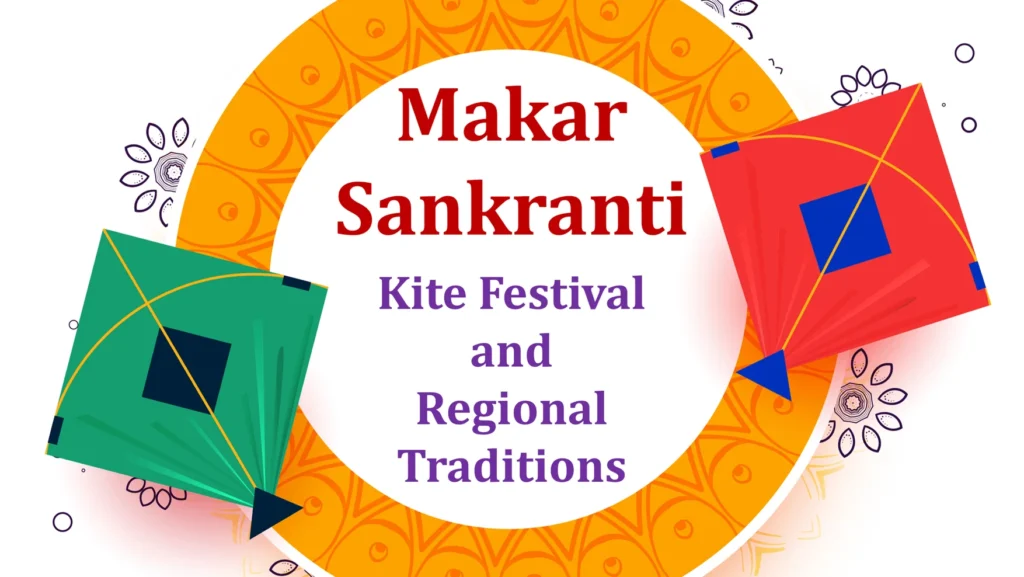
Introduction
Makar Sankranti, also known as Pongal in India, is a bright and prominent festival observed throughout the country. It holds a special significance throughout the nation. It is celebrated as Pongal in Southern India mainly in Tamil Nadu. People participate in rituals and traditions during Makar Sankranti puja engage in kite flying festivities and come together for community bonfires and gatherings. It’s a time when people can experience a range of activities from flying kites to enjoying Pongal celebrations.
Origins and Significance of Makar Sankranti
Makar Sankranti has its roots deeply embedded in thousands of years of history. The word “Makara” comes from Sanskrit representing the suns movement, into Capricorn. This celestial event does not mark the end of winter solstice but also heralds longer daylight hours ahead. Its astrological importance is believed to bring positivity and prosperity.
Besides its significance Makar Sankranti holds cultural and religious value. It is considered a harvest festival that celebrates completion of winter crop season. Farmers express their gratitude towards natures abundance while seeking blessings for a year.
Regional Variations in Makar Sankranti Celebrations
The celebrations of Makar Sankranti vary across regions, in India due to the country’s cultural landscape. The occasion becomes a combination of customs and rituals that highlight the richness of our variety.
In Maharashtra it is celebrated with the name “Makar Sankranti” with lots of joy and enthusiasm. People exchange “tilgul,” a sweet made from seeds and jaggery symbolizing the sweetness that life brings. Additionally, kite flying becomes an activity, during this time where people engage in competitions to keep their kites soaring high up in the sky.
In Tamil Nadu the festival of Makar Sankranti is celebrated as “Pongal.” This joyful occasion coincides with the Tamil month of Thai. During this four-day festival people come together to prepare a dish called Pongal, which is made using harvested rice and lentils. The entrances of homes are adorned with “Kolam” patterns creating an atmosphere accompanied by the delightful sounds of music and dance.
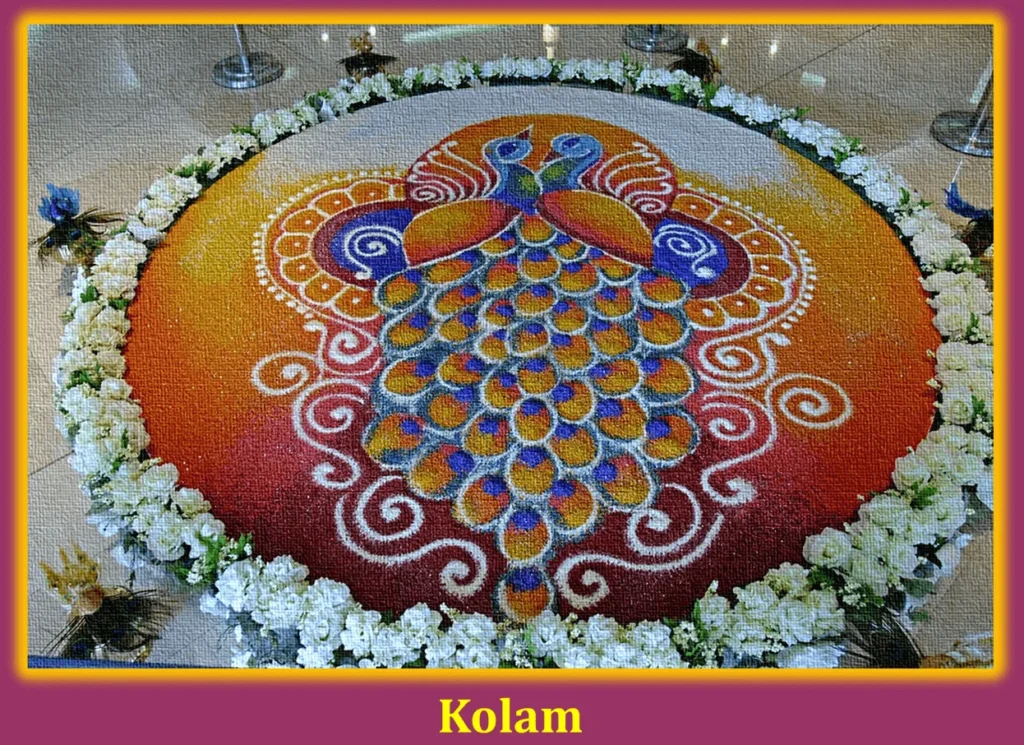
Similarly other states, like Gujarat, Punjab and Rajasthan have their ways of celebrating Makar Sankranti. These regional variations reflect the influence of practices and cultural customs that have evolved over time.
Festive Decorations
The preparations for Makar Sankranti are filled with joy as families engage in cleaning and decorating rituals for their homes. Together they create a lively environment to welcome this festival.
Colorful rangoli patterns decorate the floors of houses adding warmth and charm to the surroundings. These intricate designs created using powders flower petals or rice flour hold significance during the celebration. Each pattern carries its symbolism believed to bring fortune and prosperity.
During Makar Sankranti festivities people also dress in attire along with accessories. Women wear sarees adorned with flowers, in their hair while men don turbans and ethnic clothing. These traditional outfits contribute to the atmosphere and foster a feeling of togetherness.
“Let us celebrate the vibrant tapestry of Indian culture and come together in the spirit of Makar Sankranti.”
Makar Sankranti Rituals and Traditions
Makar Sankranti Puja Rituals
The worship customs observed during the celebration of Makar Sankranti are deeply rooted, in our traditions and spiritual beliefs. Devotees express their gratitude for a harvest. Seek blessings for a prosperous future by offering prayers to the Sun God.
Preparation and setup for the puja
Preparations for the worship begin in advance with homes adorned in decorations. The worship area is meticulously. Decorated with flowers and rangolis which’re beautiful traditional artworks made using colored powders or flower petals.
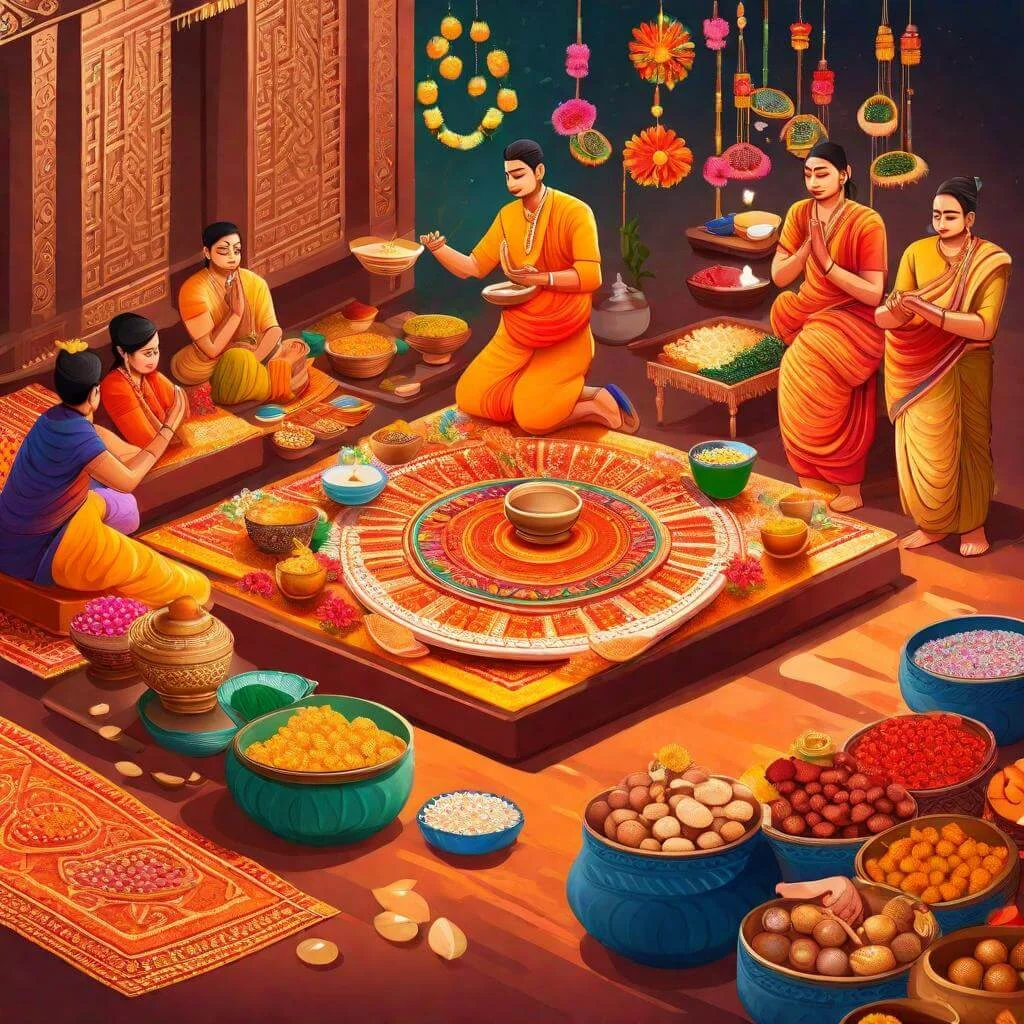
Recitation of mantras and prayers
During the worship ceremony devotees chant mantras and hymns dedicated to Lord Surya (the Sun God). These sacred chants create an atmosphere of devotion. Invoke blessings.
Ritualistic offerings and their significance
The worship ceremony involves offering items, to the Sun God, including fruits, flowers, sweets and grains. Each item holds significance representing fertility, abundance and gratitude.
The Soaring Skies: Kite Flying Festival
Kite flying has always been a part of India’s heritage and carries great historical importance especially during Makar Sankranti.
Historical and cultural importance of kite flying
Kite flying during Makar Sankranti traces its roots back to ancient times. It is believed that the practice symbolizes the desire to overcome obstacles and soar high like a kite, signifying prosperity and good fortune.
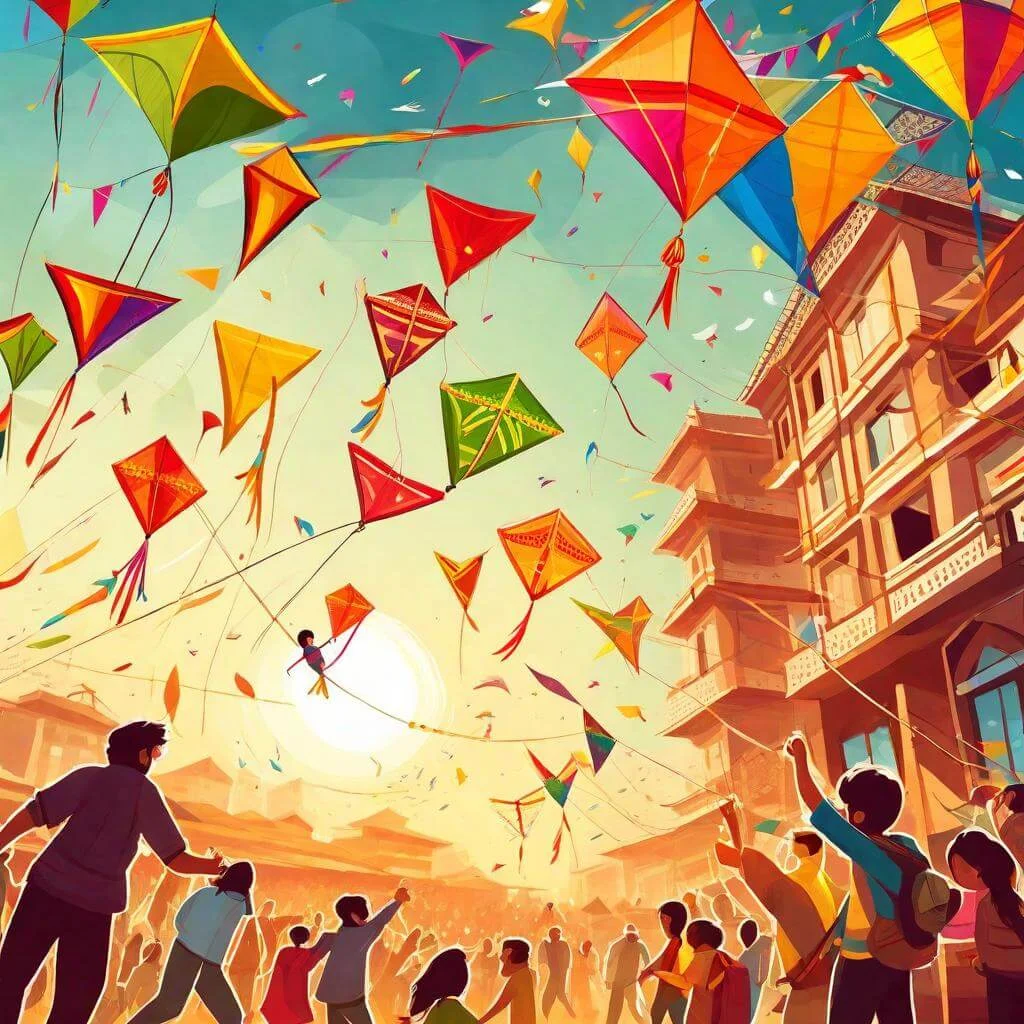
Techniques and materials used for making kites
Craftsmen meticulously create kites using bamboo, paper, and vibrant colors. The art of making kites involves intricate designs and patterns, passed down through generations. Techniques like adding tails and balancing the kite for stability are essential for successful flights.
Kite flying competitions and popular destinations
Kite flying competitions are one of the parts of the celebrations, during Makar Sankranti. Enthusiasts get a chance to display their talent and innovative approaches. Kite flying hotspots such as Ahmedabad and Jaipur attract participants from all around the nation. These events foster not just a sense of community but also healthy competitiveness among participants.
Bonfires and Community Gatherings
Bonfires and communal get togethers are an aspect of Makar Sankranti festivities bringing a sense of warmth and unity to the ambiance.
Building and lighting bonfires during Makar Sankranti
The tradition of building bonfires, known as Meji, symbolizes the end of winter and the arrival of longer days. Bonfires are constructed using wood, cow dung, and wheat stalks, with different regions having their unique variations.
Symbolism and beliefs associated with Meji (bonfire)
It is considered to have the ability to fight off evil spirits while bringing good fortune and wealth. As the fire crackles, reflecting its brightness against the night sky, it makes a captivating scene. People gather around this fire engaging in songs, dances and celebrations that foster a profound sense of unity and joy.
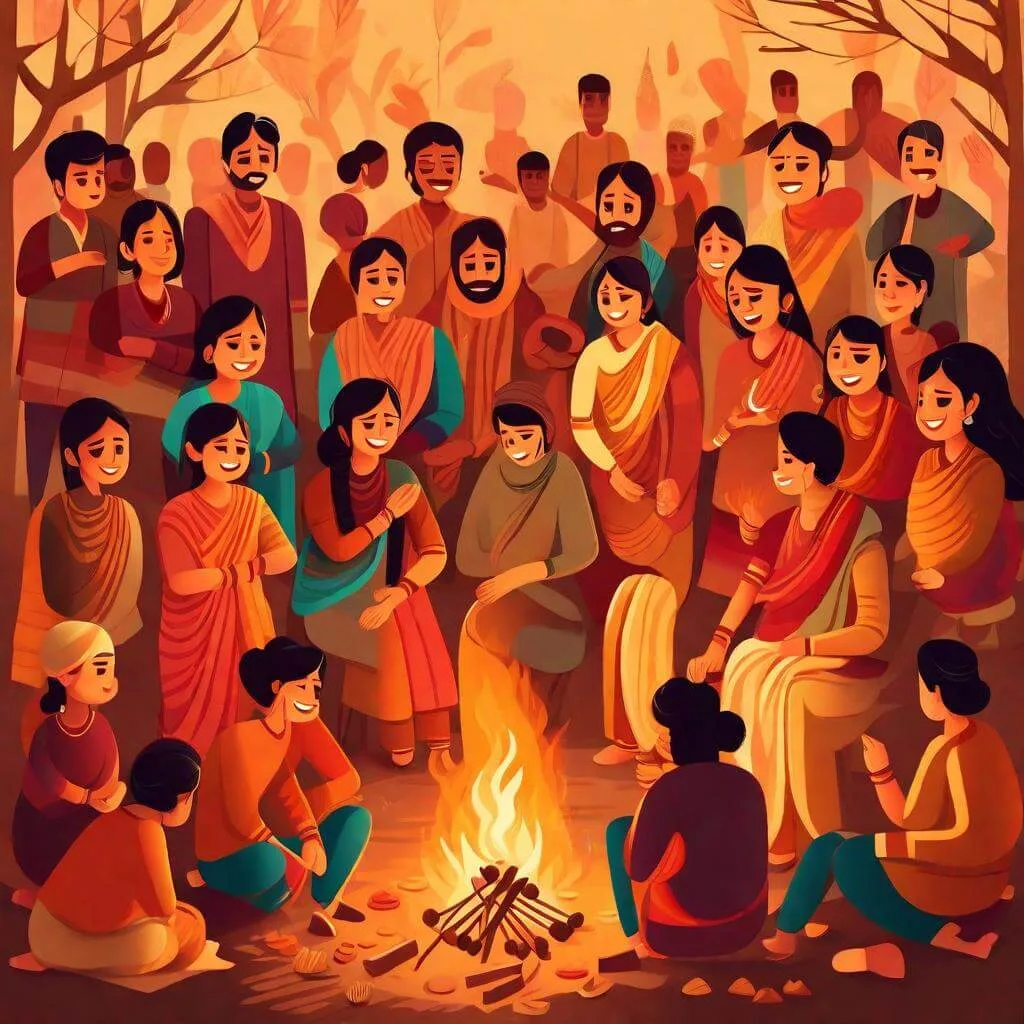
Community feasts and cultural performances
Makar Sankranti is a time for communities to get together and share community feasts, rather than a time for celebration. Til laddoos (sesame seed sweet balls) and Pongal (a meal prepared with newly harvested rice) are served during these meetings. The scrumptious food is savored by everyone while cultural performances like folk dances and music elevate the atmosphere with their energy.
Culinary Delights of Makar Sankranti
Sweets and Snacks for Traditional Occasions
No Makar Sankranti celebration is truly fulfilling without enjoying a variety of sweets and snacks. Among them Tilgul holds a place. A treat made from sesame seeds and jaggery. These small bite sized delicacies represent the sharing of affection and good wishes, among ones. The combination of seeds combined with the sweetness of jaggery offers a burst of flavors with each mouthful.
In addition to Tilgul different regions, across India have their offerings when it comes to delightful, sweet treats. In Maharashtra individuals enjoy Puran Poli, and bread filled with lentils, jaggery and cardamom. Meanwhile in Uttar Pradesh Makar Sankranti is celebrated with the rewri and gajak both made from seeds and jaggery. These diverse sweet delicacies truly showcase India’s traditions and vibrant cultural diversity.
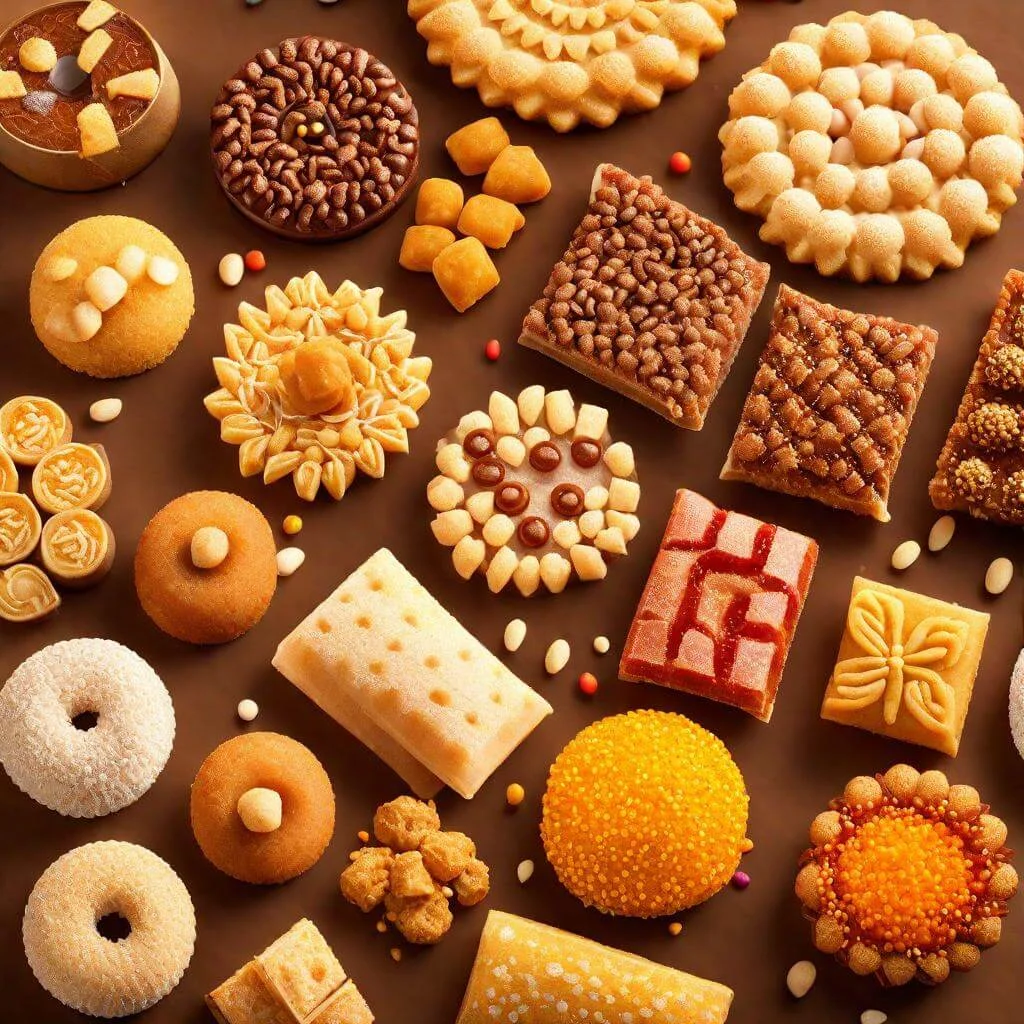
During Makar Sankranti, there are several savory snack alternatives to pick from. From crunchy tilkut with sesame seeds to chikkis with peanuts and jaggery, these snacks offer the right combination of tastes. These appetizers’ crunchiness and slight sweetness make them an excellent complement to kite flying and social events throughout the festival.
Makar Sankranti Special Dishes
Pongal in South India
Pongal is a joyful festive observed throughout South India. However, Pongal is also the name of a rice dish prepared with rice, lentils, ghee, and cashews. It is usually cooked outside in clay pots to honor the sun deity. It is considered auspicious when the pot of Pongal overflows, symbolizing abundance and prosperity. Typically served with coconut chutney and sambar (a lentil soup) this comforting meal brings joy.
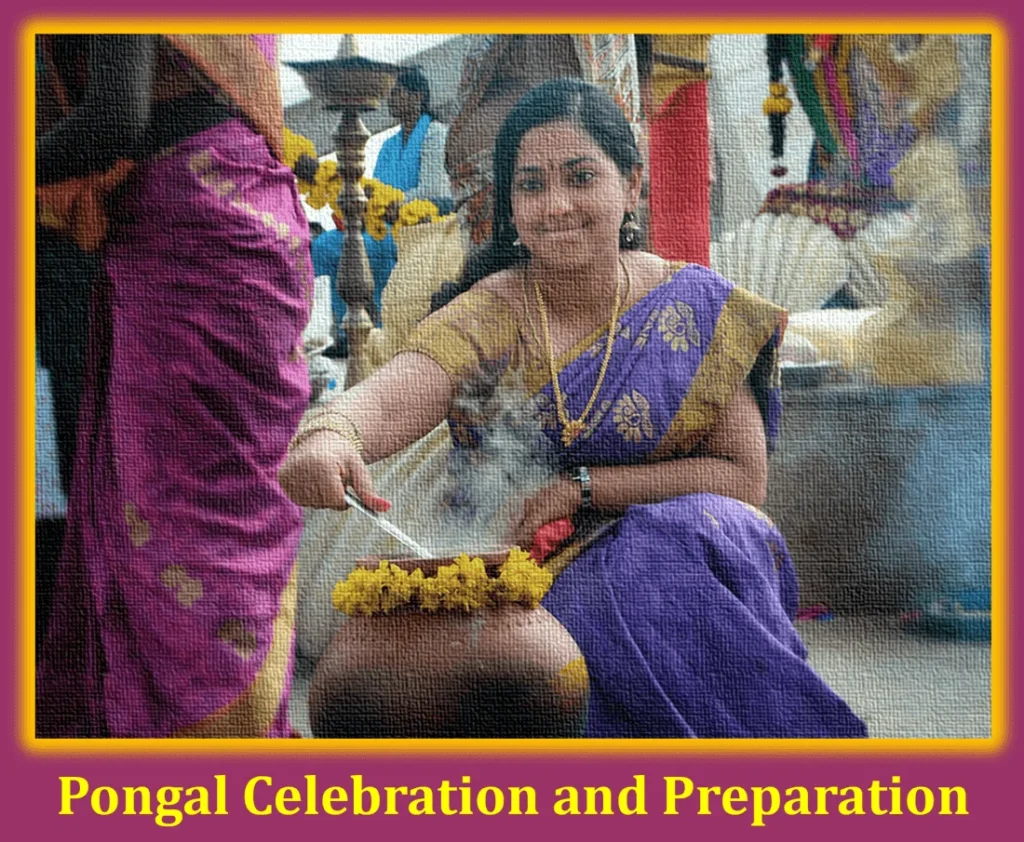
Khichdi in North India
Moving to North India Makar Sankranti is closely associated with a humble yet satisfying one pot meal known as khichdi. This delightful dish combines rice, lentils and seasonal vegetables to signify beginnings and purification of the body and soul. Often accompanied by a dollop of ghee along with pickles, papad (crispy wafers) and yogurt, on the side khichdi unites families in sharing happiness and warmth.
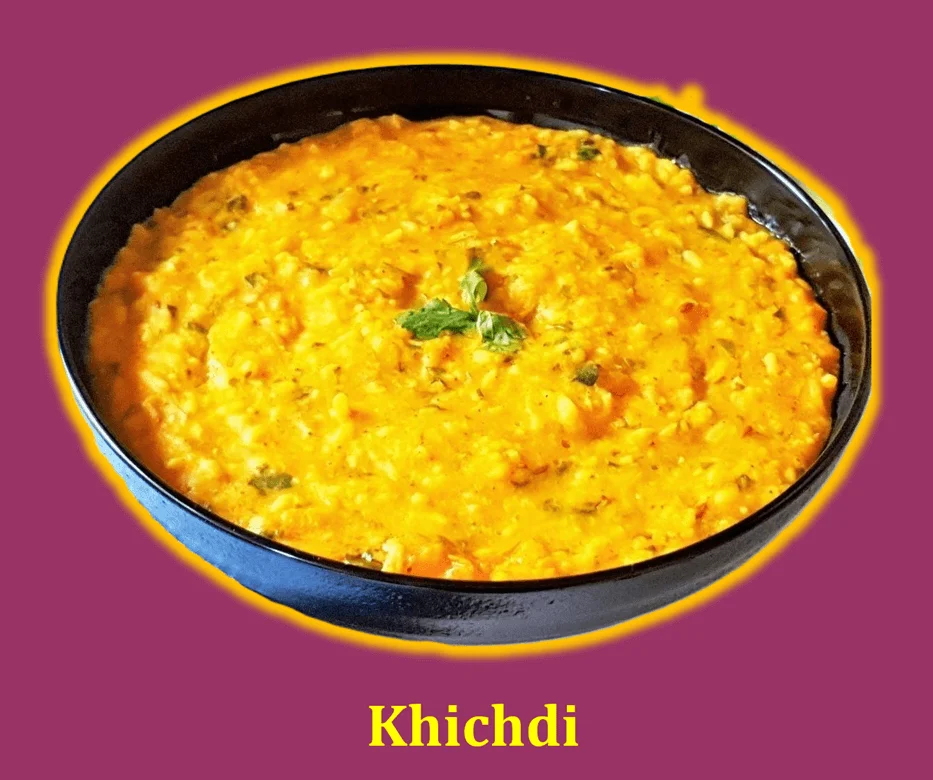
Magh Bihu in Assam
In Assam the festival of Makar Sankranti also known as Magh Bihu centers around a delicacy called “Pitha.” Pitha is a rice cake prepared by combining rice with jaggery (cane sugar). Grated coconut. These delightful treats come in forms like steamed, fried or baked. Pitha represents optimism, new beginnings and the abundance of the harvest in Assam.
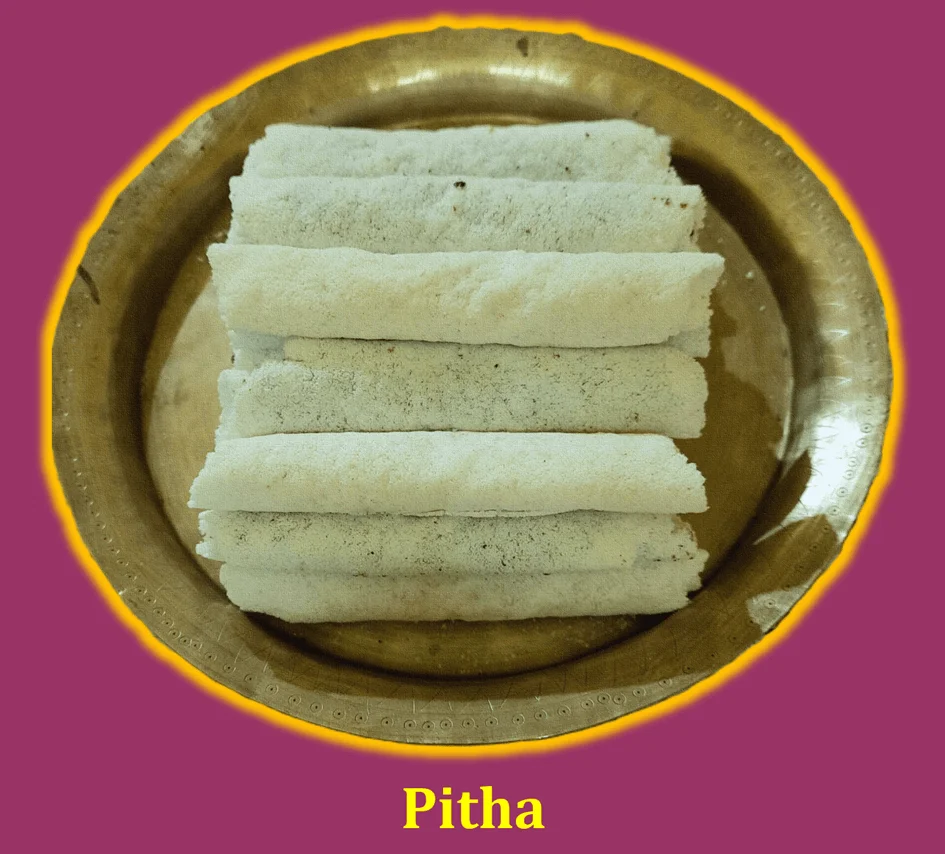
During Makar Sankranti regions of India prepare dishes that highlight the importance of ingredients. It is common to find dishes made with harvested ingredients such as rice, lentils and vegetables emphasizing the connection between natures blessings and the festival.
Vibrant Foods and Customs
Sharing food and sweets with friends and family
Exchanging food and sweets with friends and family is a practice that symbolizes sharing love, happiness and good fortune. Homemade delicacies like Tilgul ( seed and Khichdi (rice lentil dish) are thoughtfully packaged and exchanged to strengthen social bonds and foster a sense of community. The act of gifting food signifies goodwill while spreading joy among loved ones.
Customs for food exchanges
Different regions, in India have their own distinct traditions when it comes to exchanging food during Makar Sankranti. During the festival individuals share a plate called “Sankranti Nu Ladoo,” which includes sesame and jaggery sweets as well, as other seasonal treats. In Punjab families exchange a mixture of til, gur (jaggery) moongphali (peanuts). Rewri, as a representation of warmth, sweetness and prosperity. These local traditions contribute to the culinary customs observed during the festival.
Symbolism of sharing food during Makar Sankranti
Symbolism, behind the act of sharing food during Makar Sankranti goes beyond sustenance. It represents the spirit of unity. Emphasizes the value of spreading joy and abundance. Through the exchange of food people honor the significance of community. Strengthen their connections with friends, family and neighbors. This collective experience fosters a sense of belonging. Creates memories.
“In the beauty of friendship there should be laughter and enjoyment shared.”
–Khalil Gibran
Makar Sankranti in Art, Music and Literature
Folk Songs and Dance Performances
Signature folk songs associated with Makar Sankranti
Makar Sankranti holds a special place in the hearts of Indians, who express their joy and excitement through various folk songs. One such popular song is “Til Gud Ghya, God God Bola” which means “Eat sesame and jaggery, and speak sweetly.” This song is sung as a way to spread sesame and jaggery symbolizing goodwill and unity. The lyrics not express the importance of the festival but also inspire people to cultivate harmonious relationships.
Traditional dance forms performed during the festival
Dance styles play a role, in the festivities of Makar Sankranti. One of the known dance performances is Garba, known for its motions and vibrant outfits. Dancers, dressed in attire, spin and twirl to the beat of music creating an atmosphere of joy and unity. Another captivating dance form that adds allure, to the celebrations is Bhangra, a lively dance originating from Punjab. The rhythmic drumbeats and spirited movements mirror the enthusiasm associated with this festival.
Evolution and modern adaptations of art forms
Over the course of time the traditional artistic expressions linked to Makar Sankranti have undergone changes. Incorporated elements. For example, in times Makar Sankranti celebrations have embraced fusion music and modern dance forms. Artists experiment with new styles while preserving the essence of the festival. This adaptation allows the festival to resonate with the younger generation and ensures its continued relevance in the modern era.
Makar Sankranti in Literature and Mythology
Ancient scriptures and their mentions of Makar Sankranti
The festival of Makar Sankranti holds significance, in mythology and ancient texts. According to beliefs the revered sage Vyasa, known for writing the Mahabharata commenced his dictation on the day of Makar Sankranti. This connection to a work further enhances the cultural and historical importance of the festival.
Folklore and mythological tales linked to Makar Sankranti
folklore stories and mythological tales are intertwined with the celebration of Makar Sankranti. One such tale revolves around the Sun God, Surya, who is said to change his course on this day. It symbolizes the end of winter solstice. Heralds days ahead. Additionally there is a legend associated with Lord Indras battle against Vritra, a demon. These stories not. Also impart valuable life lessons that instill morality and ethics among people.
Contemporary literature influenced by the festival
Makar Sankranti continues to inspire writers who infuse its essence into their creations. The festivals symbolism, representing the transition from darkness to light and promoting unity serves as a muse, for authors. With their writings they document the emotions, customs and principles linked to Makar Sankranti guaranteeing that its vibrant cultural legacy is safeguarded for generations.
Visual Representations of Makar Sankranti
Makar Sankranti depicted in paintings and murals
Artists from over India have beautifully portrayed the spirit of Makar Sankranti in their enchanting paintings and murals. These artistic creations often portray the sight of people flying kites under the sun. The use of colors and intricate details beautifully captures the spirit of joy and enthusiasm that surrounds this festival. Moreover, these visual representations serve as a way to preserve and showcase the customs and traditions from different regions.
Traditional motifs and symbols used in art
The art associated with Makar Sankranti frequently incorporates symbols and motifs that hold cultural and religious significance. Among these the kite stands out as a symbol representing freedom and the aspiration to reach heights. Additionally, motifs like the sun, birds and floral patterns are commonly used in these artworks to depict natures essence and symbolize renewal. Elements closely associated with this festival.
Visual documentation of regional celebrations
A fascinating aspect of Makar Sankranti is its diversity in celebrations across parts of India. From Pongal, a harvest festival celebrated in Tamil Nadu to Uttarayan, in Gujarat each region contributes its visual representation to enhance the festivities. Intricate rangoli designs adorning doorsteps colorful traditional attire worn by celebrants and beautifully crafted structures are a few examples of how these regional celebrations are visually documented.
“Makar Sankranti is a celebration of art, music, and literature that brings communities together, transcending boundaries and fostering a sense of unity.”
Summary & FAQs
Key Takeaways from Makar Sankranti
Makar Sankranti is a celebration that is celebrated in parts of India. In this blog post we will delve into the agricultural importance of Makar Sankranti, the way it exemplifies unity amidst diversity during its celebrations. How it fosters social cohesion and community bonding.
Cultural and agricultural significance
Makar Sankranti holds agricultural importance in India. It signifies the transition of the sun, into the zodiac sign of Capricorn marking the end of winter solstice and the beginning of days. This auspicious time is celebrated with baths in rivers and prayers offered to the sun god as a symbol of new beginnings.
From a perspective Makar Sankranti represents the harvest season. Farmers rejoice during this festival expressing gratitude for crops and seeking blessings for a harvest in the upcoming year. The festival serves as a reminder of the connection between humans and nature emphasizing farming practices.
Celebrating unity amidst diversity
India is renowned for its tapestry and Makar Sankranti beautifully exemplifies how this diversity is celebrated harmoniously. The festival takes on forms, across states and regions showcasing their distinct traditions.
In Gujarat people engage in flying kites as symbols of freedom and joy. The sky undergoes a transformation, as a variety of kites each, in shapes and sizes put on a captivating spectacle.
Pongal is a festival that is celebrated in Tamil Nadu. It involves the making of a dish called “Pongal.” This delightful delicacy is crafted using harvested rice, jaggery and milk. The festivities also include bonfires, traditional dances and exciting cattle races that take place in regions, across India.
Despite the variations, in regions what remains consistent is the essence of happiness, togetherness and inclusiveness. People from communities and backgrounds come together to partake in the festivities breaking barriers and spreading a feeling of unity and harmony.
Impact on unity and community bonding
Makar Sankranti serves as a catalyst for unity and community bonding. The celebrations bring people together to participate in activities fostering a sense of camaraderie and shared experiences.
During kite flying competitions, neighbors and friends gather on rooftops forming teams and assisting each other in making their kites soar higher. Laughter, cheers and friendly banter fill the air strengthening bonds between individuals and creating memories. Similarly during rice harvest celebrations, families and communities gather to cook the Pongal dish together creating an environment of shared joy and abundance.
Makar Sankranti promotes the concept of unity and collective celebration while nurturing feelings of belongingness and inclusivity, within communities. It provides an opportunity for people to connect with one another interact with cultures ultimately contributing towards building a society that embraces diversity.
“Makar Sankranti showcases the spirit of India’s coexistence serving as a poignant reminder of the significance of unity.”
Frequently Asked Questions (FAQs)
Why is Makar Sankranti observed in January?
Makar Sankranti is celebrated in January to mark the suns transition into the zodiac sign of Capricorn. This event takes place annually around January 14th or 15th. The festival symbolizes the changing seasons with days and the commencement of harvest time, in parts of India.
How long do Makar Sankranti festivities usually last?
The duration of Makar Sankranti festivities can vary depending on the region and specific customs followed. In some areas celebrations may span one day while in others they may extend up to four days. For example, in Gujarat people engage enthusiastically in kite flying activities for days.
Are there any safety precautions for kite flying?
Certainly! It’s important to take safety measures into account while indulging in kite flying to ensure a delightful experience. Opting for spaces away from power lines and crowded areas is crucial when choosing a spot to fly kites. Avoid using metallic strings as they can pose risks for injuries. Additionally, it’s vital to supervise children and take precautions, against accidents to ensure everyone’s well-being.
